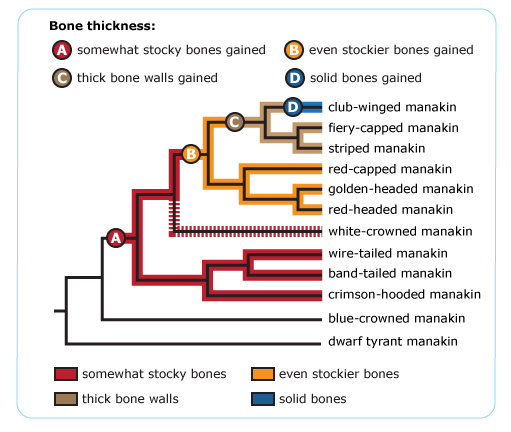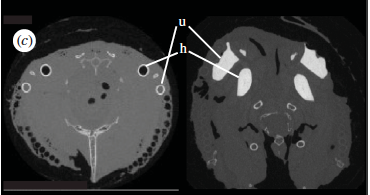Manakin Mating Behaviors
- Biology 342 Fall 2016 -
Erin Howell and Morgan Vague
Phylogeny:
Phylogeny addresses the development of behavior over time.
Sexual Selection
As opposed to natural selection, sexual selection often involves temporary traits that an animal uses to attract a mate. Sometimes these traits become permanent over time. These traits can hinder the animal greatly in terms of survival but are selected for because they help the animal reproduce (Fusani, 2014). Several studies looking at manakins reveal particular sexual selection for physical, rather than the more commonly studied vocal traits used in mating displays.
For example, a study comparing manakin species found that those with more complicated acrobatic mating dances had developed larger brains. Additionally, although the males and females of each species had similar sized brains, the females tended to have larger visual systems and the males had larger motor systems. However, these species were ordinary in other non-sexual behaviors (Lindsay, 2015). Only males of species that do acrobatics have as much development of neuromuscular systems (Fusani, 2014). 
WingSnap Development Across Generations
A study comparing manakin species found that those with more complicated acrobatic mating dances had developed larger brains. Additionally, although the males and females of each species had similar sized brains, the females tended to have larger visual systems and the males had larger motor systems. However, these species were ordinary in other non-sexual behaviors (Lindsay, 2015). Only males of species that do acrobatics have as much development of neuromuscular systems (Fusani, 2014).
The species of manakin that are able to create sound by rubbing their wings together also might have produced this trait through sexual rather than natural selection. One study indicated that the radius and size of the bones, which are similar across manakin species that produce the noise, were not necessary for flight and therefore might be produced by sexual selection. (Friscia, 2016).
Most bird species exhibit a “hollow form” bone density phenotype, which maximizes flexural strength and stiffness to aid flight (Botswick, 2012). Club-winged manakins however, display a different phenotype. Male club winged manakins have solidified ulnae that are 3 times the size of other bird species, which leads to heavy bones that hinder flight (Botswick, 2012). Attached to their large ulnae are enlarged feathers that are used to perform wingsnaps during courtship displays (Botswick, 2012). This indicates that the club winged manakin wing morphology is driven by sexual selection, as it is specialized for courtship displays, at the cost of diminished flight ability (Botswick, 2012).
Since these studies show specialized physical mating behaviors are not compulsory for survival, related species of manakin have developed similar mating behaviors and sexual characteristics because of sexual pressure rather than natural selection.
